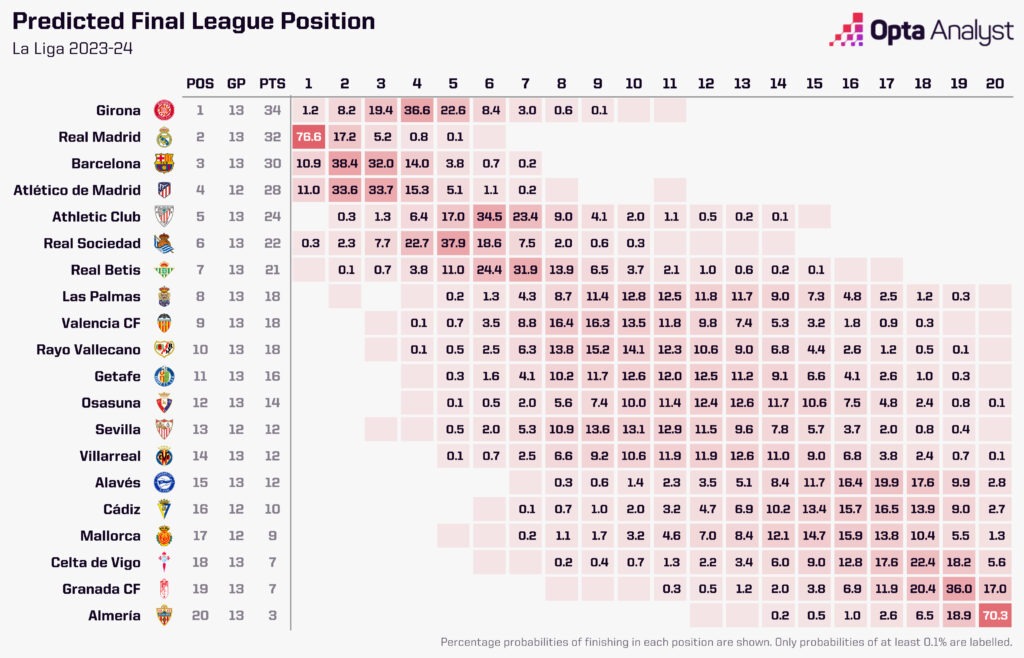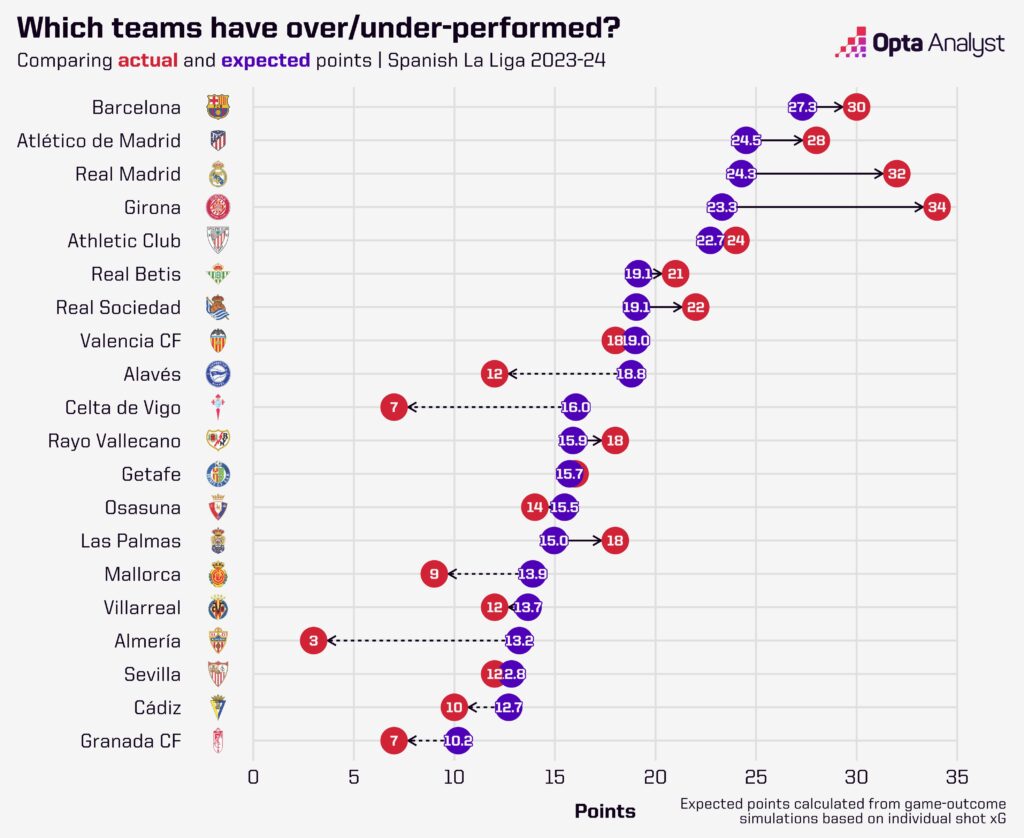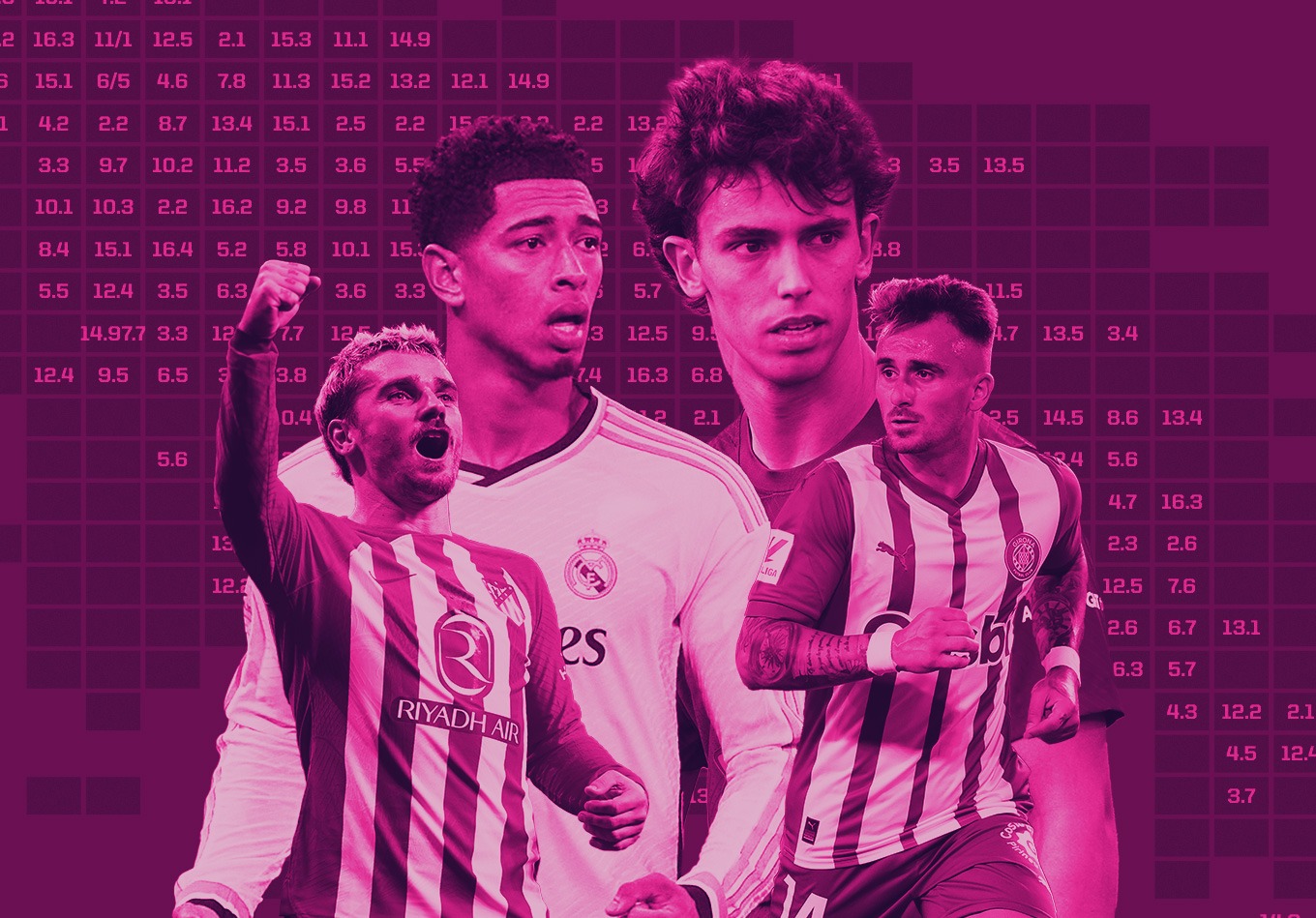With domestic action about to resume following the international break, we provide an update to our La Liga season predictions with Girona the unlikely leaders after 13 rounds.
La Liga Season Predictions: The Quick Hits
Title Favourites: Real Madrid
Top Four: Real Madrid, Barcelona, Atlético Madrid, Girona
Relegation Candidates: Celta Vigo, Granada, Almería
Suffice to say, when we asked the Opta supercomputer to predict how La Liga 2023-24 would play out in pre-season, it didn’t chuck out Girona as potential title winners. Granted, it still doesn’t expect them to go the distance, but after 13 matches they’re the ones sitting top of the table.
Back in August, the supercomputer’s number-crunching led to the prediction model holding Real Madrid up as the likeliest winners of the Spanish top-flight title, and they are at least there or thereabouts.
With 13 rounds of fixtures in the bag for all but four teams, and the action set to resume on Friday after the international break, now seemed as good a time as any to revisit the predictions and check what – if anything – has changed in the title race, the battle for Europe and the relegation scrap.
The table below provides a percentage that corresponds to how often in 10,000 season simulations each club finished in a given position, and after that you’ll find our analysis.

Who Will Win La Liga in 2023-24?
Despite Girona sitting top of La Liga with a two-point cushion heading into the weekend, the supercomputer still doesn’t fancy their chances of claiming what would probably be the most remarkable title triumph anywhere in Europe in living memory. Given the financial disparity between Spain’s biggest clubs and nearly everyone else, Girona winning the title would arguably trump Leicester City’s incredible Premier League success of 2015-16.
Alas, Jude Bellingham-led Real Madrid are still considered massive favourites by the prediction model, which, based on the 10,000 simulations, thinks Carlo Ancelotti’s side have a 76.6% chance of wresting the crown back from Barcelona.
The supercomputer’s pre-season prediction also marked that as the likeliest outcome, though Madrid’s success probability has increased significantly over the past three months, shooting up from 47.7% to 76.6%. Back in August, Barcelona’s likelihood of retaining their title was rated at 25.9%, though it’s fallen to less than half that at 10.9%; their 2-1 home defeat in October’s El Clásico almost certainly having an impact there.
In fact, Barcelona are now considered third favourites behind Madrid and Atlético Madrid (11%), who’ve looked reenergised and reimagined this season. Diego Simeone’s side have also seen their title chances decrease, according to the supercomputer, as they began the season at 19.3%. Nevertheless, they went into the international break only two points behind third-placed Barcelona with a game in hand, and following a run of eight wins in 10 games, certainly look capable of being a threat in light of the injury crises being experienced by their two rivals.
At the moment, though, it’s Girona leading the charge. While you have to mention they are under the same ownership umbrella as Manchester City, there’s still a great story behind their unlikely title challenge. They’re thriving with a youthful group of players, several of whom have really made names for themselves this term, including Yan Couto, Artem Dovbyk, Sávio and Aleix García, who last week became the club’s first Spain international in their 93-year history. It’s also worth noting they’d never been in La Liga prior to 2017-18, and this is only their second season back in the top flight after three years in the second tier.
But considering their complete lack of experience in a title race like this, it’s perhaps not that surprising the supercomputer expects them to tail off down the line; they’re top and clear of Madrid by two points, but their title hopes are rated at just 1.2%.
Nevertheless, a top-four finish for Girona would also be an excellent achievement, and they managed that in 65.4% of simulations; that’s a pretty substantial improvement from roughly 0.9% before the season began.
The only other club to finish top in more than 0.1% of the latest season simulations were Real Sociedad (0.3%), though they are already 12 points off the pace.
Who Will Qualify For Europe?
With Real Madrid, Barcelona, Atlético and Girona breaking clear of the rest of the pack, there’s a chance the top-four spots could be wrapped up fairly early.
Aside from those four, the only other club given more than a 10% chance of breaking into the guaranteed UEFA Champions League places in the latest simulations were Real Sociedad (33%), but again that’s a fairly sizable decrease from before a ball was kicked when they were considered the team most likely to challenge the big two and Atlético. Back then, their top-four chances were rated at 51%.
But we mustn’t forget, fifth could also be a route into the Champions League. In the new format of the competition starting from next season, the two best-performing countries in the previous European campaign each get an extra qualification spot.
Fifth is where La Real are likeliest to end the season (37.9%), so if Spanish clubs don’t do that well in the European competitions this term, the UEFA Europa League will beckon, with the supercomputer expecting them and bitter rivals Athletic Bilbao to switch places between now and then; sixth (34.5%) was where Ernesto Valverde’s men finished most often, and at the moment that would see them qualify for the UEFA Europa Conference League.
Sixth would become a Europa League spot and seventh will qualify for the Europa Conference League if the winners of the Copa del Rey finish in the top five; Real Betis were predicted to come sixth in pre-season and they’re the only one of the three clubs in spots five, six or seven back then to still be in the running.
Villarreal were given an 80.6% likelihood of finishing in the top seven and Sevilla had been deemed likeliest to come seventh, but both clubs have endured difficult starts to the season. In the latest simulations, Villarreal finished between fifth and seventh 3.3% of the time and never as high as fourth, while Sevilla are given a 7.5% probability of ending the campaign in the three places outside the top four.
Of course, Sevilla could still drop from the Champions League into the Europa League, which they’d presumably go on to win again; after all, they did so last term despite flirting with relegation for much of the season.
So, as you can see, the battle for European places looks a little muddy at this stage.
Who Will Be Relegated From La Liga in 2023-24?
At the start of the campaign, the supercomputer unsurprisingly considered the three promoted clubs – Las Palmas, Deportivo Alavés and Granada – as the most likely to go down, but it still painted a picture of the relegation scrap being quite open.
Back then, as many as seven clubs were relegated in at least 19% of simulations whereas none topped 41.7%; now, though, things look rather clearer.
Granada are the only one of the newcomers to be in the bottom three and so the supercomputer gives them a hefty 73.4% probability of sliding straight back to the Segúnda, while rock-bottom Almería are nearly without hope already.
Granted, they were one of the seven clubs expected to struggle, but they’ve accumulated just three points from 13 matches and were relegated in 95.7% of the most recent simulations, finishing bottom in nearly three quarters of them.
Celta Vigo have been plagued by bad luck this season and, as such, are rated by the supercomputer as the third-likeliest side to tumble out of the top tier. Rafa Benítez’s side have struggled to replace several key players, while the usually reliable Iago Aspas is finding goals much trickier to come by. On top of that, Celta have fallen victim to some contentious – at least in their eyes – refereeing decisions.
All this adds up to being relegated in 46.2% of the simulations; Alavés (30.3%) and Cádiz (25.6%) are the only other clubs at the moment whose chances are above 19%, although Mallorca (18.2%) sit between them and the relegation zone.
Special praise should be reserved for Las Palmas, however. In pre-season, the prediction model made them the most likely to finish bottom (16.3%); now, sitting at the lofty heights of eighth, García Pimienta’s side are dreaming of Europe. They were relegated in less than 1.6% of the most recent season simulations and are currently on course for their first top-half finish in La Liga since 1978-79 (sixth).
La Liga Expected Points
Our expected points model simulates the number of goals scored by each side in each match based on the expected goals (xG) value of every shot taken. It then uses the simulated number of goals to determine the match outcome (win/draw/loss), with each game run through the model 10,000 times. The expected points for each team in every match can then be calculated based on the proportion of simulations they win/draw/lose. This is of course not an exact science, as xG data doesn’t include a lot of factors, such as game state and dangerous periods of possession that don’t lead to shots.
Nevertheless, the model allows us to essentially distil the underlying numbers into an ‘expected’ league table that pinpoints clubs who are underachieving or overachieving.

The fact Celta have only accumulated seven points from 16 expected points puts their misfortune and frustration into numerical context, and the same could be said of Almería; according to the model, they should have 10 more points than they do.
Sevilla have been one of the main beneficiaries of the underachievement of teams around them. Although their 12 points matches very closely with their 12.8 expected points, only two clubs have poorer records in this metric – essentially, they’d be in the relegation zone if the table were actually determined by expected points, which highlights how underwhelming they’ve been under José Luis Mendilibar and his successor Diego Alonso this season.
As for overachievers, it won’t be a huge surprise to see Girona with the biggest positive difference between points and expected points (10.7), but it bears remembering their 23.3 expected points is still good enough for fourth in La Liga.
Opta-Simulated La Liga 2023-24 Table
After simulating the remainder of the 2023-24 season 10,000 times, we’re able to average the points total of every club across those simulations and therefore rank teams positionally. Here’s the Opta supercomputer results from those simulations:
1st: Real Madrid
2nd: Barcelona
3rd: Atlético Madrid
4th: Girona
5th: Real Sociedad
6th: Athletic Club
7th: Real Betis
8th: Valencia
9th: Rayo Vallecano
10th: Sevilla
11th: Getafe
12th: Las Palmas
13th: Villarreal
14th: Osasuna
15th: Mallorca
16th: Cádiz
17th: Alavés
18th: Celta Vigo
19th: Granada
20th: Almería
How Does the Opta Supercomputer Model Work?
- Opta’s League Prediction model estimates the likelihood of teams finishing in each position in the competition. We can therefore see how successful a team’s season is likely to be, whether it is their relegation or title chances.
- The model estimates the probability of each match outcome (win, draw or loss) by using betting market odds and Opta Power Rankings. The odds and rankings are based on historical and recent team performances.
- The model considers the strength of opponents by using these match outcome probabilities and simulates the remaining fixtures in the competition thousands of times. By analysing the outcome of each of these simulations, the model can see how often teams finished in each league position to create final predictions.
Enjoy this? Subscribe to our new football newsletter to receive exclusive weekly content. You should also follow our social accounts over on X, Instagram, TikTok and Facebook.
